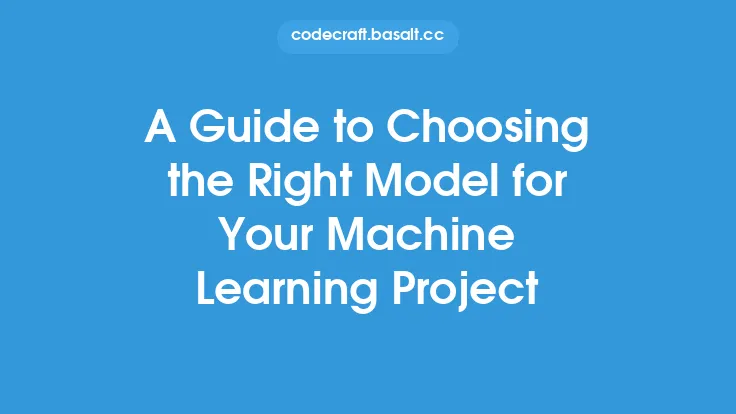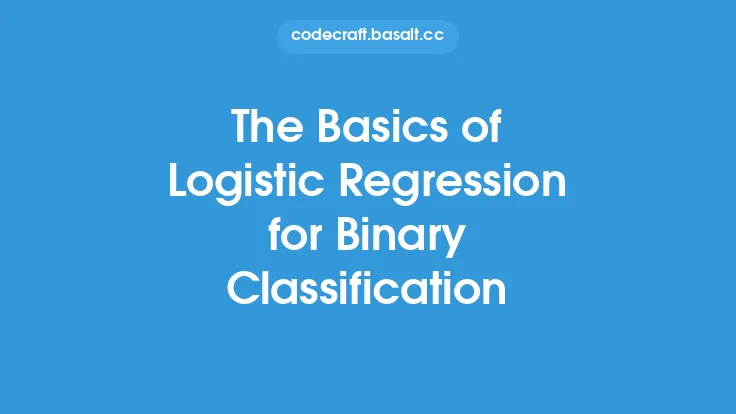When it comes to machine learning, classification algorithms are a crucial component, enabling machines to categorize data into different classes or labels. With numerous classification algorithms available, selecting the most suitable one for a specific problem can be a daunting task. The choice of algorithm depends on various factors, including the nature of the data, the complexity of the problem, and the desired level of accuracy. In this article, we will delve into the process of selecting the right classification algorithm for a given task, exploring the key considerations and trade-offs involved.
Understanding the Problem Domain
Before selecting a classification algorithm, it is essential to understand the problem domain and the characteristics of the data. This includes identifying the type of classification problem (binary or multi-class), the number of features, and the distribution of the data. For instance, if the problem involves classifying images, a convolutional neural network (CNN) might be a suitable choice, whereas for text classification, a recurrent neural network (RNN) or a support vector machine (SVM) could be more appropriate. Understanding the problem domain also involves identifying any specific requirements or constraints, such as the need for interpretability or the availability of computational resources.
Evaluating Algorithmic Complexity
The complexity of a classification algorithm is a critical factor in determining its suitability for a given problem. Algorithms with high complexity, such as neural networks, can learn complex patterns in the data but may require large amounts of computational resources and training data. On the other hand, simpler algorithms, such as logistic regression or decision trees, may be less accurate but are often more interpretable and require fewer resources. The choice of algorithmic complexity depends on the specific problem and the available resources. For example, if the problem involves a large dataset with many features, a more complex algorithm like a random forest or a gradient boosting machine (GBM) might be necessary to capture the underlying patterns.
Considering Overfitting and Underfitting
Overfitting and underfitting are two common issues that can arise when training a classification model. Overfitting occurs when a model is too complex and learns the noise in the training data, resulting in poor generalization performance on new, unseen data. Underfitting, on the other hand, occurs when a model is too simple and fails to capture the underlying patterns in the data. To mitigate these issues, it is essential to select an algorithm that balances model complexity with regularization techniques, such as L1 or L2 regularization, dropout, or early stopping. Additionally, techniques like cross-validation and grid search can help identify the optimal hyperparameters for a given algorithm and prevent overfitting.
Assessing Interpretability and Explainability
In many applications, interpretability and explainability are crucial aspects of a classification model. Algorithms like decision trees, logistic regression, and SVMs are often more interpretable than complex models like neural networks or ensemble methods. However, techniques like feature importance, partial dependence plots, and SHAP values can help provide insights into the decision-making process of more complex models. When selecting a classification algorithm, it is essential to consider the need for interpretability and explainability, as well as the availability of techniques to provide insights into the model's behavior.
Handling Imbalanced Datasets
Imbalanced datasets, where one class has a significantly larger number of instances than others, can pose a challenge for classification algorithms. In such cases, algorithms like SVMs, random forests, and GBMs can be effective, as they can handle class imbalance through techniques like class weighting, oversampling the minority class, or undersampling the majority class. Additionally, metrics like precision, recall, and F1-score can provide a more comprehensive understanding of a model's performance on imbalanced datasets, rather than relying solely on accuracy.
Comparing Algorithmic Performance
When selecting a classification algorithm, it is essential to compare the performance of different algorithms on a given dataset. This can be done using metrics like accuracy, precision, recall, F1-score, and area under the receiver operating characteristic (ROC) curve. Additionally, techniques like cross-validation and bootstrapping can help estimate the variability of a model's performance and provide a more robust comparison of different algorithms. It is also important to consider the computational resources required by each algorithm, as well as the availability of implementation libraries and frameworks.
Conclusion and Future Directions
Selecting the right classification algorithm for a given problem is a critical step in machine learning. By understanding the problem domain, evaluating algorithmic complexity, considering overfitting and underfitting, assessing interpretability and explainability, handling imbalanced datasets, and comparing algorithmic performance, practitioners can make informed decisions about which algorithm to use. As machine learning continues to evolve, new algorithms and techniques are being developed, and the choice of classification algorithm will depend on the specific requirements of the problem and the available resources. By staying up-to-date with the latest developments and advancements in classification algorithms, practitioners can ensure that they are using the most effective tools for their specific use cases.





